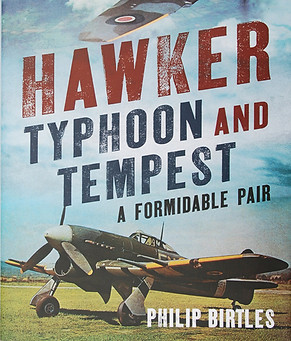Military Model Scene
Robin Buckland's
Hawker Typhoon and Tempest...
...a Formidable Pair , from Fonthill Media

Title: Hawker Typhoon and Tempest
Author: Philip Birtles
Publisher: Fonthill Media
ISBN: 978-1-78155-690-0
I think that if you mention Tornado and Typhoon then the modern aircraft enthusiast will most likely turn their mind to modern fast jets, but these two names a both featured in the early development stages of what became a famous ground attack aircraft during WW2. The Tornado was a design using the Rolls Royce Vulture engine, while the Typhoon used the new Napier Sabre engine. It was the Sabre engined Typhoon that came out the winner. A second Tornado variant used the Centaurus engine, which was later developed into the Tempest II. The development story is told in detail, including problems with the early engines and with the weak tail assembly. It was however the first RAF fighter capable of 400mph+ and carried a heavyweight 4x cannon armament as standard.
Then we get into the early service story of the Typhoon, being used on defensive duties along the South Coast against Luftwaffe intruders, and later moving on to carrying out their own mix of intruder operations over the Continent. Additions of bombs and then rocket projectiles and changes in organisation are all explained. Then there were missions against the V1 sites in the Pas de Calais, later extending to the anti-diver (against V-1s once they were in the air). Come the Normandy invasion of course we get to the best known use of the Typhoon, in ground attack operations and the so-called 'cab ranks'. Despite greater reliability, losses continued, but more from flak and even others from mis-identification and so-called friendly fire.
Then there is the topic of the Tempest. Built with a redesigned, thinner wing, providing better performance at height against the newer Luftwaffe fighters. One design used wing mounted radiators rather than the large chin mounted option, but eventually it was the chin mounted style that went into production. It was left for the Tempest II to use the Centaurus radial engine. Having covered the development of the Tempest it goes on to detail the service/combat story as well. The final chapters go on to look at post-war service not only with the RAF but with foreign air forces who were looking to rebuild their air forces after the war.
Another excellent book from author Philip Birtles and Fonthill Media. I learnt a lot more about both the Typhoon and Tempest and the informative text is accompanied throughout by a large number of fine archive photos. All is rounded off by Pilot's Notes and 6 Appendices giving tables with a large set of additional details on deployments, Typhoon and Tempest production and serials etc.. A first class book.
Thanks to Fonthill Media for our review copy.
Robin